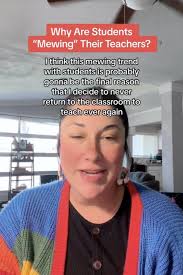The Rise of “Mewing”
In recent times, the “mewing” trend has gained traction on social media platforms. Named after Professor John Mew, this method involves flattening the tongue against the roof of the mouth. Advocates claim it can lift the jawline and alleviate jaw and mouth muscle pain. However, its effectiveness has been questioned by experts, including the American Association of Orthodontists.
A Non-Verbal Gesture
Beyond its purported benefits for jawline aesthetics, there’s another dimension to the “mewing” trend that has caught the attention of educators. Teresa Newman, a teacher, highlighted a concerning behavior associated with “mewing” among her students. She observed that when students engage in “mewing,” they often put their finger over their mouth and slide it down their jawline. This action serves as a signal that they do not wish to participate or answer questions in class.
Lack of Respect in the Classroom
Newman expressed her disapproval of the “mewing” trend in schools, citing concerns about its impact on classroom dynamics. She noted that students use this non-verbal gesture as a way to show disrespect to their teachers without the teachers fully understanding its meaning. According to Newman, this behavior undermines the authority of educators and disrupts the learning environment.
The Importance of Communication
One of the key issues with the “mewing” trend in schools is the lack of communication between students and teachers. Without a clear understanding of why students engage in this behavior, educators may struggle to address it effectively. It highlights the need for open dialogue and proactive measures to address emerging trends that affect classroom behavior.
Addressing Concerns Surrounding “Mewing”
While the “mewing” trend may have originated with good intentions, its unintended consequences in educational settings cannot be ignored. Teachers play a crucial role in shaping student behavior and fostering respectful communication. By addressing concerns related to “mewing” and promoting dialogue between students and educators, schools can create a more conducive learning environment.




